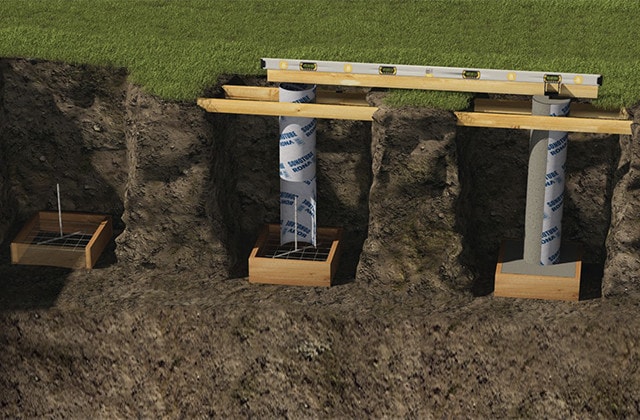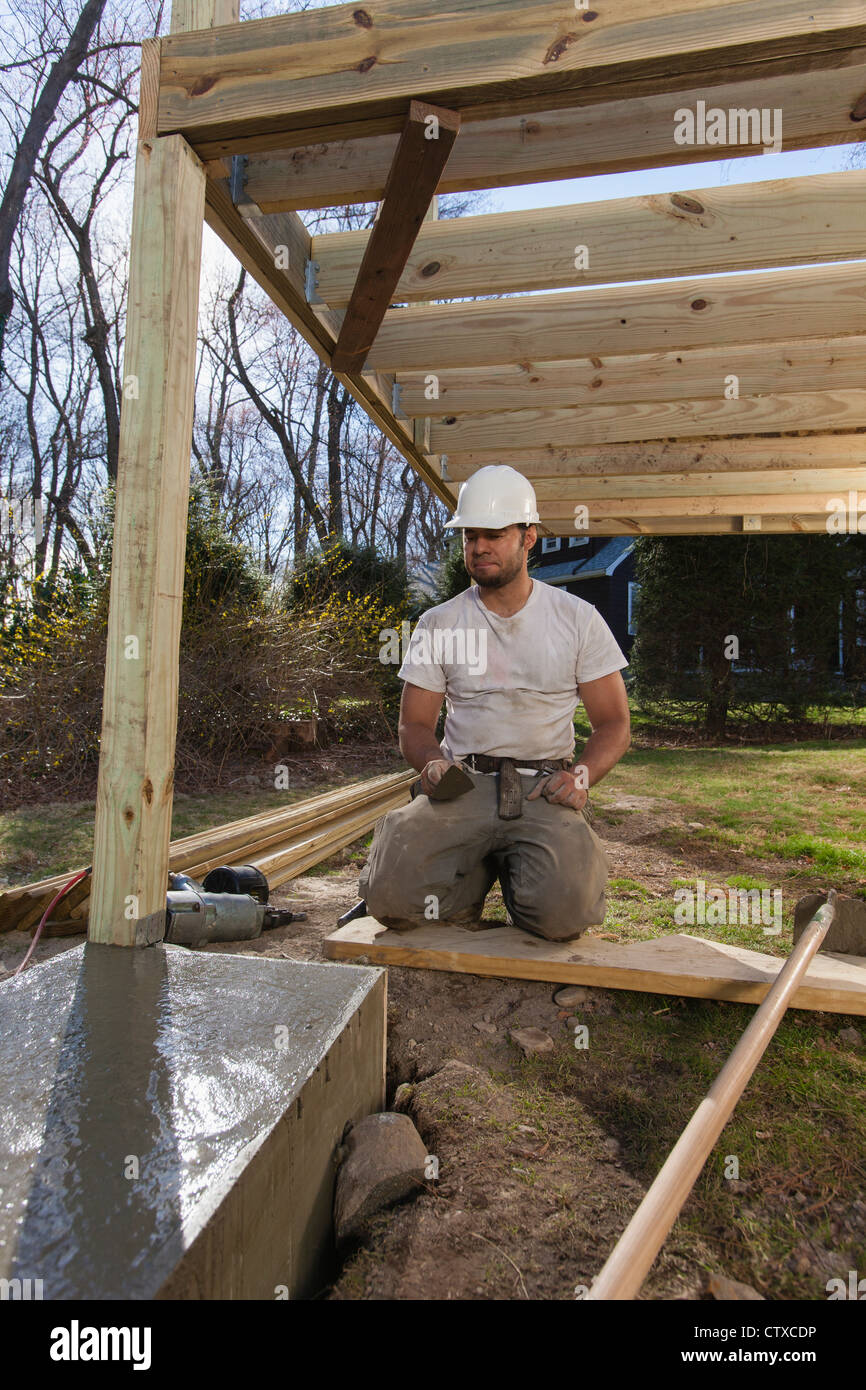Professional Tips for Installing Deck Footings to Support Your Outdoor Space
When it pertains to building a deck, among the most essential components to take into consideration is the setup of correct grounds. These footings are the structure whereupon your outdoor room will relax, offering security and support for several years to come. What precisely does it take to install deck grounds properly? In this discussion, we will certainly explore professional ideas and techniques that can help make certain a effective and durable deck installment. From choosing the ideal sort of grounds to preventing typical mistakes, we will offer you with the knowledge and insights you need to with confidence begin on your deck-building trip. So, allow's dive right in and discover the trick to a solid and lasting outdoor area.
Importance of Appropriate Deck Footings
Appropriate deck grounds are essential for guaranteeing the stability and longevity of your outside room. When building a deck, it is critical to focus on the foundation on which it will relax. Deck footings give the needed assistance for the entire structure and help distribute the weight equally - Deck Footings. Without strong and correctly installed footings, your deck might come to be unpredictable, resulting in safety threats and pricey fixings.

In addition to stability, proper deck footings likewise contribute to the longevity of your outside space (Deck Footings). Footings that are created and built to endure the aspects and soil conditions in your location will help avoid the deck from settling or moving gradually. By ensuring the grounds are appropriately sized and mounted, you can decrease the danger of damage to the deck structure, prolonging its life-span and reducing the need for costly fixings or substitutes

Selecting the Right Sort Of Grounds
When picking the ideal kind of grounds for your deck, it is essential to think about variables such as dirt problems, local building ordinance, and the general design of your exterior area. The kind of footing you pick will certainly play a vital role in making certain the stability and longevity of your deck.
One common sort of ground is the concrete footing. Concrete footings appropriate for the majority of dirt conditions and provide exceptional assistance for decks. They are generally installed below the frost line to protect against moving and clearing up due to freezing and thawing cycles. An additional choice is helical piers, which are ideal for areas with unpredictable soil or high water tables. These piers are screwed right into the ground and give strong support for the deck.
In some situations, you may need to make use of specific grounds, such as stack footings or deep structures, if you are building a multi-level or big deck. These grounds are created to disperse the weight of the deck over a bigger area, guaranteeing security and avoiding sinking or resolving.
Before picking a kind of ground, it is vital to seek advice from local building regulations and policies to ensure compliance. Additionally, think about the layout and intended use your outdoor room. Elements such as the dimension, shape, and load-bearing needs of your deck will affect the sort of footing that is most suitable.
Preparing the Ground for Footing Installment
To correctly prepare the ground for footing installation, it is crucial to assess the soil problems and take essential steps to ensure security and sturdiness of the deck. The first action is to dig deep into the area where the grounds will certainly be set up.
Once the location has actually been excavated, the next action is to portable the dirt. This can be done utilizing a plate compactor or by using a hand meddle. Compacting the soil aids to eliminate any type of spaces or air pockets, which can lead to check my source working out and instability gradually.
After condensing the dirt, it is essential to lay a layer of crushed rock or smashed rock at the base of the excavation. This will give drain and assistance to prevent water from merging around the footings, which can lead to disintegration and instability.
Step-by-Step Overview to Putting Up Deck Footings
After appropriately preparing the ground for footing setup, the following action is to start the process of setting up deck grounds. This detailed overview will certainly offer you with a clear understanding of just how to mount deck footings for your outside space.
Identify the location: Beginning by marking the settings of the deck grounds utilizing stakes and string. Make certain that the locations straighten with the layout and design of your deck.
Dig the holes: Make use of an article hole miner or an auger to dig the openings for the footings. The depth and diameter of the holes ought to remain in accordance wikipedia reference with neighborhood building regulations and the particular requirements of your deck design.
Degree the openings: Utilize a degree to make certain that the openings are dug to the proper deepness and are degree with each other. (Deck Footings)
Add crushed rock: Location a layer of gravel at the bottom of each opening to boost drainage and stop the wood from decaying.
Put the footings: Put the footings into the openings, ensuring they are degree and plumb. Use a level and a determining tape to guarantee accuracy.
Safeguard the footings: Put concrete into the holes around the grounds, filling them to the top. Utilize an article degree to make sure the footings continue to be degree as the concrete collections.
Enable time for treating: Allow the concrete treatment according to the supplier's instructions prior to proceeding with the deck construction.
Typical Blunders to Prevent During Footing Installation
One important facet to think about during the installation of deck grounds is avoiding usual mistakes that can endanger the security and durability of your outside space. While deck grounds might appear like a straightforward and easy component of the building and construction process, forgeting specific elements can cause pricey repair work and possible security hazards down the line.

Additionally, neglecting to install correct water drainage steps can trigger water to collect around the footings, resulting in rot, degeneration, and the ultimate weakening of the deck's structure. Using the wrong type of footing material or stopping working to effectively safeguard the footings can jeopardize their architectural honesty.
To prevent these blunders, it is vital to seek advice from an expert or adhere to market guidelines to make sure appropriate footing installation. By doing so, you can ensure the stability and longevity of your outside room, giving a enjoyable and risk-free environment for many years ahead.
Verdict
In verdict, mounting correct deck footings is critical for the stability and long life of your exterior room. By picking the appropriate sort of grounds and properly preparing the ground, you can make sure a solid structure for your deck. Following a detailed overview and preventing typical blunders throughout footing installment will certainly even more improve the toughness and security of your deck.
Appropriate deck grounds are important for guaranteeing the stability and durability of your outdoor room. The footings serve as a connection in between the deck and the ground, allowing the weight of the deck and its occupants to be spread Visit Website equally right into the dirt.One common type of footing is the concrete footing. Insert the grounds: Put the footings into the openings, making certain they are degree and plumb. Protect the grounds: Pour concrete right into the openings around the grounds, filling them to the top.